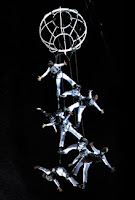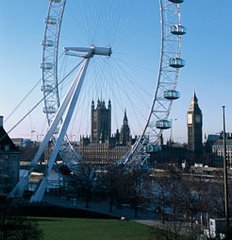First up is Gloucester Road. The station, which opened in 1906, is grade II listed and the original station building is still largely intact. The great thing about it, though, is the way it is used as a space to display art. Five-metre-high niches in the wall of the disused platform 4 have been transformed into an underground gallery to exhibit a series of installations commissioned by Platform for Art, London Underground’s public art programme.

What a laugh: Life is a Laugh is a new commission from Brian Griffiths, running from July 2007
London Underground has a long history of promoting art and design, beginning in 1908 when Frank Pick commissioned leading artists of the day, including Man Ray and Graham Sutherland, to work on London Underground poster campaigns. Then there is the distinctive red, white and blue logo, the typography and, of course, Harry Beck’s iconic map. It’s great the London Underground Ltd is carrying on this tradition with Platform for Art. And if you happen to be heading that way, keep an eye out – you might catch sight of a masterpiece.
I like Tottenham Court Road station for the spectacular mosaics that cover the walls; they really are very beautiful. There are more than 1,000 square metres of murals, installed during the early 1980s and designed by Sir Eduardo Paolozzi. The murals feature in the ticket hall, the escalators, the rotunda and on the platforms of the Central and Northern lines, the two lines that serve the station, and each is different. The frenetic design on the Central line platforms reflects the station’s position close to Tottenham Court Road’s large concentration of hi-fi and electronics shops, and Paolozzi’s signature appears in several places in the murals. Those millions of little coloured tiles really brighten up the long escalator journey to ground level.

Platform art: Eduardo Paolozzi was a Scottish sculptor and artist, he was knighted in 1989
The station was also used for a scene in An American Werewolf in London.
Westminster is my favourite station. The architecture is amazing – like something from a stark sci-fi movie. The new station was designed by Michael Hopkins & Partners in the 1990s when it was decided to join up the District & Circle line with the much deeper Jubilee, London Underground’s newest line. It’s a futuristic vision of concrete, glass and huge steel beams and buttresses, which are actually the foundations of Portcullis House. Travelling up (or down) the escalators is simply breathtaking, it’s worth travelling from the District & Circle line to Jubilee just for the experience.

Future shock: The Piranesian-style design creates a sci-fi fantasy
In another film-related aside, the station is used the forthcoming adaptation of Harry Potter and the Order of the Phoenix.



